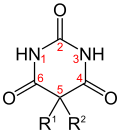Barbiturates
Barbiturates are derivatives of barbituric acid. They are well absorbed from the intestine, they can be given "per os". The onset and duration of the effect depends on the ratio of solubility in fatty solvents and in water. They bind to albumin, but the free component is effective. Degradation takes place in the liver, excretion in the kidneys. Degradation takes place by disulfuration by liver enzymes to oxybarbiturate of medium duration of action. Elimination of many barbiturates is slow (eg Template:HVLP has a half-life of 11.5 hours), so repeated administration may lead to accumulation. Barbiturates do not have a specific antagonist.
Effect[edit | edit source]
Barbiturates act on the GABA-Cl complex. They affect chloride channel function even without the presence of GABA. They cause disorders REM sleep.
Usage[edit | edit source]
In low doses it is used as a sedative, in higher doses it has a hypnotic effect. They can be used as antiepileptic for their anticonvulsant effect. They were used to treat insomnia. Barbiturates, which contain sulfur in their molecule, are used to induce anesthesia.
Contraindications[edit | edit source]
Side effects[edit | edit source]
- barbiturates are inducers of mitochondrial enzymes - they affect the metabolism of other drugs (mostly acceleration of metabolism)
- suppresses the respiratory center - must be applied slowly, otherwise there is an apnoeic pause
- confusion
- disorders consciousness
- addiction and severe withdrawal symptoms (spasms, heart rhythm disorders)
Substances used[edit | edit source]
ThiopentalTemplate:HVLP
- i.v. filing
- at induction of anesthesia (part of the previous dose remains in the body, when administering the next dose or for outpatient procedures, the patient must wait 1-2 hours after application until all thiopental is washed out)
PhenobarbitalTemplate:HVLP
- long-term effect
- hypnotic effect
- antiepileptic – inhibits excitation through the glutamate receptor (prevents the occurrence of pathological irritation)
- strongly induces microsomal enzymes in the liver
- teratogenic effect
Next:
- Hexobarbital
- Cyclobarbital
Poisons[edit | edit source]
In case of poisoning, it is necessary to carry out dialysis and alkalinization urine.
- at acidic pH (non-ionized form) – barbiturates are not removed from the body, they are filtered through the filter membrane, but reabsorbed
- at alkaline pH (after administration of bicarbonate) – barbiturates are removed from the blood and brain (via HEB)
"Strychnine" can be used as an antidote
Links[edit | edit source]
Related Articles[edit | edit source]
References[edit | edit source]
- HYNIA, Sixtus. Pharmacology in a Nutshell. 2. edition. Prague : Triton, 2001. ISBN 80-7254-181-1.
References[edit | edit source]
- ↑ SPC ON THE DRUG THIOPENTAL VALEANT,. SPC - thiopental [online]. [cit. 2017-01-12]. <https://www.sukl.cz/modules/medication/detail.php?code=0216673&tab=texts>.

